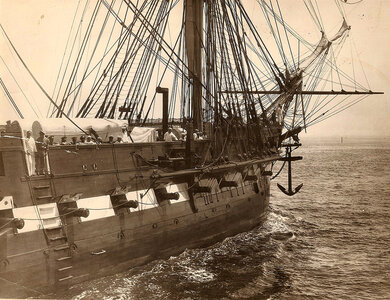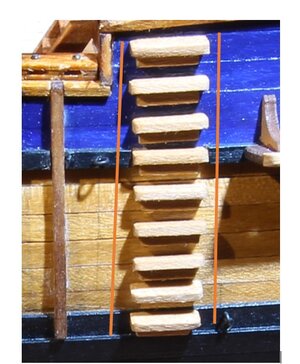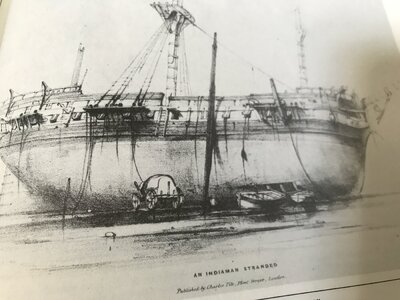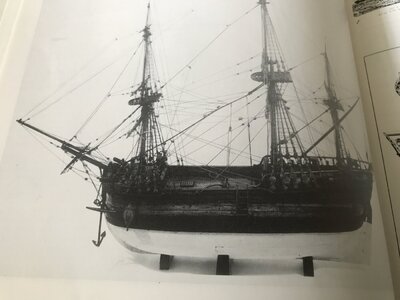-

Win a Free Custom Engraved Brass Coin!!!
As a way to introduce our brass coins to the community, we will raffle off a free coin during the month of August. Follow link ABOVE for instructions for entering.
You are using an out of date browser. It may not display this or other websites correctly.
You should upgrade or use an alternative browser.
You should upgrade or use an alternative browser.
I had a quick look at Marquardt’s Endeavour book and the plans in the Parkin set and, as far as I can see, there is no indication of manropes as indicated in your photo.
In more modern times the use of manropes suspended alongside the pilot ladder is quite common. Some port authorities, pilots and Administrations mandate their use. However, there’s been ongoing debate for decades as to their benefit. I suspect the builder of the model you saw used artistic freedom based on experience of later seamanship practices. The use of those manropes has advantages and disadvantages in use when embarking and disembarking.
In more modern times the use of manropes suspended alongside the pilot ladder is quite common. Some port authorities, pilots and Administrations mandate their use. However, there’s been ongoing debate for decades as to their benefit. I suspect the builder of the model you saw used artistic freedom based on experience of later seamanship practices. The use of those manropes has advantages and disadvantages in use when embarking and disembarking.
Yes, I have Marquardt's book as well, and didn't find any reference to any manropes either. My supposition is that such manropes would have been used to embark the ship from a rowing boat, as boarding a ship while in port would have been via a boarding bridge from the harbour to the ship. I stand corrected if my supposition is not correct.
It would be interesting to learn what theses steps would have been used for.
It would be interesting to learn what theses steps would have been used for.
Last edited:
Yes, I have Marquardt's book as well, and didn't find any reference to any manropes either. My supposition is that such manropes would have been used to embark the ship from a rowing boat, as boarding a ship while in port would have been via a boarding bridge from the harbour to the ship. I stand corrected if my supposition is not the correct.
It would be interesting to learn what theses steps would have been used for.
I agree with you. A gangway (from ship or shore) would generally be used on the landward side and the “ladder” on the seaward side from boats, tenders etc.
When you look at the construction of typical sailing ship “ladders” they cannot have been easy to use, especially in inclement weather. To me the practice of good seamanship would indicate ropes were additionally used. Pilot ladders of today are more easy to hold onto and manropes provide a little more security. SOLAS now mandates manropes for ships after a certain date.
I saw something similar on Jeronimo's incredible build of the French Seventy-Four, which I am now modeling, and wondered if I should include it. It makes sense that there should be something to hold on to, but it's the first time I've seen ropes in this area modeled.
Last edited:
I’m Still working on the Grimsby, it has 2 ladders going to the upper Bow deck area, I was thinking of making a brass handrail there. Can’t imaging going up there on a ship without holding on to something. This pic is from a book I copied 25 years ago, not sure what book it was
Attachments
The manropes would not normally be visible on a model as they would be rigged only when someone uses the steps.
However they were unavoidably used for boarding any vessel with more than three steps freeboard above the boats gunnel.
You'd not be able to hold onto anything else, and certainly not the steps themselves..
However they were unavoidably used for boarding any vessel with more than three steps freeboard above the boats gunnel.
You'd not be able to hold onto anything else, and certainly not the steps themselves..
This is of interest to me, too, since I'm currently building a 16th century galleon. I have no knowledge of when the ropes were used or introduced, but it does make sense to have them. Even on galleons, such as I'm currently making, there would be times when a Master would send people ashore using a logboat. to get passengers aboard from a rowing boat, I'd guess that ropes would be a must. Wet and slippery tar-covered rungs would be scary for a 'land-lubber'.
Encre de Chine, you seem to endorse the idea of ropes being used, but only rigged when people were boarding. That would mean that modellers should at the very least add cleats or eyes for the ropes. After that, adding the lines would be up to the modeller. Why do you say that they were not permanently rigged?
I'd like to add this detail as authentically as I can to my galleon.
Encre de Chine, you seem to endorse the idea of ropes being used, but only rigged when people were boarding. That would mean that modellers should at the very least add cleats or eyes for the ropes. After that, adding the lines would be up to the modeller. Why do you say that they were not permanently rigged?
I'd like to add this detail as authentically as I can to my galleon.
When I reread my post of yesterday I realized many of you might be confused why I introduced “pilot ladders” into Luigisoft’s initial question. The reason is that many of our more modern practices at sea are inherited from those of times long ago. So let me explain a little and hopefully clarify and probably pique some interest in the possible use of those manropes on sailing ships and how we have a carry over to more modern times.
The ship-side “ladders” on sailing ships of old are solid fixed in place treads, if fitted. They are there to assist in boarding and disembarking the ship. As has been pointed out they would be next to impossible to hold onto as a person ascends or descends the ship side. So it only makes sense that a rope or ropes would be used as grablines (we now call them manropes). Continuing on from that the rope would have been fixed to a secure point at the ship side or on deck and be available as necessary. Would it be left in position at sea? I personally doubt it but we cannot know for sure. I would expect the deck of the vessel to be cleared and secured of all non-essential gear before departing on a sea voyage.
So back to my comment about pilot ladders. In the marine industry the pilot ladder is used, as might be expected, primarily for the boarding and departing of the pilot, crew and other ship/shore personnel. It is not constructed like the sailing ships of old. They are portable and constructed in such a way (regulated) that when deployed the wooden treads tend to lay against the ship side. Much like the fixed solid treads of the sailing ships. However, the ladder is constructed of two separate ropes on each side (not manropes). These ladder side ropes pass through the treads. The treads are then secured and spaced using chocks above and below the treads (sometimes called widgets). These are then tied off with line. This means when climbing or descending the pilot ladder there is sufficient room for your hands to grip the side ropes. You do not grip the treads and it would be foolhardy to do so. This tends to reinforce the discussion of not using the fixed in place treads on a sailing ship.
The use of manropes has been around for a long, long time. Their use now is also to assist personnel when using the pilot ladder. They are useful when descending the ladder where you can use a manrope in each hand in a sliding motion. If you think about it your feet are on the treads and you use the ropes as hand holds. Ascending is a different matter. It is really awkward to climb a pilot ladder using the manropes especially in a sea and swell. It is, to me, safer to grab the side ropes of the actual ladder as you climb up.
Did I base this on conjecture? No, I have climbed and descended the damn things a great many times. If you want a scary thought think of a very heavy swell off Cape Town, a rise and fall of way, way more than 30 feet, wind howling and nervous panic trying to climb a pilot ladder as the boat you just stepped off at the peak of the wave, now drops in the trough and quickly rises fast beneath you feet as you climb faster than a sword in teeth boarding party .
.
A long winded post but I think if we have to guess and wonder about practices of old them maybe we should look at similar sea practices of today to give us a clue.
The ship-side “ladders” on sailing ships of old are solid fixed in place treads, if fitted. They are there to assist in boarding and disembarking the ship. As has been pointed out they would be next to impossible to hold onto as a person ascends or descends the ship side. So it only makes sense that a rope or ropes would be used as grablines (we now call them manropes). Continuing on from that the rope would have been fixed to a secure point at the ship side or on deck and be available as necessary. Would it be left in position at sea? I personally doubt it but we cannot know for sure. I would expect the deck of the vessel to be cleared and secured of all non-essential gear before departing on a sea voyage.
So back to my comment about pilot ladders. In the marine industry the pilot ladder is used, as might be expected, primarily for the boarding and departing of the pilot, crew and other ship/shore personnel. It is not constructed like the sailing ships of old. They are portable and constructed in such a way (regulated) that when deployed the wooden treads tend to lay against the ship side. Much like the fixed solid treads of the sailing ships. However, the ladder is constructed of two separate ropes on each side (not manropes). These ladder side ropes pass through the treads. The treads are then secured and spaced using chocks above and below the treads (sometimes called widgets). These are then tied off with line. This means when climbing or descending the pilot ladder there is sufficient room for your hands to grip the side ropes. You do not grip the treads and it would be foolhardy to do so. This tends to reinforce the discussion of not using the fixed in place treads on a sailing ship.
The use of manropes has been around for a long, long time. Their use now is also to assist personnel when using the pilot ladder. They are useful when descending the ladder where you can use a manrope in each hand in a sliding motion. If you think about it your feet are on the treads and you use the ropes as hand holds. Ascending is a different matter. It is really awkward to climb a pilot ladder using the manropes especially in a sea and swell. It is, to me, safer to grab the side ropes of the actual ladder as you climb up.
Did I base this on conjecture? No, I have climbed and descended the damn things a great many times. If you want a scary thought think of a very heavy swell off Cape Town, a rise and fall of way, way more than 30 feet, wind howling and nervous panic trying to climb a pilot ladder as the boat you just stepped off at the peak of the wave, now drops in the trough and quickly rises fast beneath you feet as you climb faster than a sword in teeth boarding party
 .
.A long winded post but I think if we have to guess and wonder about practices of old them maybe we should look at similar sea practices of today to give us a clue.
The ropes would have to be clean, and were sometimes served with fabric to make them more presentable on the Sb side.This is of interest to me, too, since I'm currently building a 16th century galleon. I have no knowledge of when the ropes were used or introduced, but it does make sense to have them. Even on galleons, such as I'm currently making, there would be times when a Master would send people ashore using a logboat. to get passengers aboard from a rowing boat, I'd guess that ropes would be a must. Wet and slippery tar-covered rungs would be scary for a 'land-lubber'.
Encre de Chine, you seem to endorse the idea of ropes being used, but only rigged when people were boarding. That would mean that modellers should at the very least add cleats or eyes for the ropes. After that, adding the lines would be up to the modeller. Why do you say that they were not permanently rigged?
I'd like to add this detail as authentically as I can to my galleon.
Letting them hang at sea would only damage and soil them.
Consider that are not fixed at the bottom, so taking them up is 30 seconds work for the guy closing the entry port.
So, in a nutshell, ladders at the steps when the ship was at harbour and no ladders when at sea.
An easier way to visualize is:So, in a nutshell, ladders at the steps when the ship was at harbour and no ladders when at sea.
- Sailing ship with fixed treads and provided with rope or ropes to assist personnel whenever they are ascending or descending at anchor, in a roadstead, alongside, and as necessary for the transfer of personnel at sea, etc. Ropes no doubt stowed away on sea passage and when not required.
- For modern day practices a portable pilot ladder is similarly used and/or an embarkation ladder. There are also personnel ladders of similar construction to the pilot ladder. All portable ladders, ropes and other gear is secured for sea and stowed away when not required.
It’s poor seamanship to leave “stuff” hanging over the ships side on passage.
Agreed. I would assume the ropes for the ladder would have been threaded through eye rings or similar either side of the steps when in use and a length of rope left hanging through the lowest eye ring to facilitate pulling the ropes back in for stowing.An easier way to visualize is:
- Sailing ship with fixed treads and provided with rope or ropes to assist personnel whenever they are ascending or descending at anchor, in a roadstead, alongside, and as necessary for the transfer of personnel at sea, etc. Ropes no doubt stowed away on sea passage and when not required.
- For modern day practices a portable pilot ladder is similarly used and/or an embarkation ladder. There are also personnel ladders of similar construction to the pilot ladder. All portable ladders, ropes and other gear is secured for sea and stowed away when not required.
It’s poor seamanship to leave “stuff” hanging over the ships side on passage.
Last edited:
So, in response to the replies so far, I assume that no ropes should be visible for boarding ladders, but some means of rigging them would probably be left in place. If it was me building the ship, I'd most likely have a single belaying pin in line with the centre of the fixed steps. A simple double-hitch?* around this and throw the 'boarding rope' over the gunwales and... job done! I don't know, but looking at these fixed steps, I'd like to hang onto a single rope and lean backwards, using the edges of the steps. I'd guess that the steps are only needed because the hull of the ship, covered in pitch and water, would be very slippery at times, never mind if it was sailing in the arctic or antarctic and the hull was covered in rime and frost. This might also answer my thought that the 'steps' are too far apart to use as a conventional ladder. If you're walking up with a rope, the 'steps' can be further apart... I'm talking 15th/16th century sail ships here.
* probably not the correct nautical term here. I refer to wrapping a figure of 8 twice around a cleat. It doesn't need to be knotted and won't slip.
* probably not the correct nautical term here. I refer to wrapping a figure of 8 twice around a cleat. It doesn't need to be knotted and won't slip.
What you write is what I would envisage too. Single rope, deployed as needed, possibly spaced figure of 8 knots along the rope to assist.So, in response to the replies so far, I assume that no ropes should be visible for boarding ladders, but some means of rigging them would probably be left in place. If it was me building the ship, I'd most likely have a single belaying pin in line with the centre of the fixed steps. A simple double-hitch?* around this and throw the 'boarding rope' over the gunwales and... job done! I don't know, but looking at these fixed steps, I'd like to hang onto a single rope and lean backwards, using the edges of the steps. I'd guess that the steps are only needed because the hull of the ship, covered in pitch and water, would be very slippery at times, never mind if it was sailing in the arctic or antarctic and the hull was covered in rime and frost. This might also answer my thought that the 'steps' are too far apart to use as a conventional ladder. If you're walking up with a rope, the 'steps' can be further apart... I'm talking 15th/16th century sail ships here.
* probably not the correct nautical term here. I refer to wrapping a figure of 8 twice around a cleat. It doesn't need to be knotted and won't slip.
RogerD, you don't know (or possibly you do know!) how much that means to me. I'm going to add one little detail to my San Francisco that will represent the boarding ladder more correctly. I'm going for a small shelf and belaying pin. Who can say that I'm wrong? It would work and be easy... so it's what they may have done. I suppose, I could add the ropes with knots, near the ladder. That'd be cool.
Thanks for your kind words..RogerD, you don't know (or possibly you do know!) how much that means to me. I'm going to add one little detail to my San Francisco that will represent the boarding ladder more correctly. I'm going for a small shelf and belaying pin. Who can say that I'm wrong? It would work and be easy... so it's what they may have done. I suppose, I could add the ropes with knots, near the ladder. That'd be cool.
…. and I just found this photo showing a two rope rig they used for this particular ship (Constitution?). Note the way the lines run through eyebolts but this is very much more recent times. Your decision to use knotted rope/s on the older depiction of your model would add some fun, interesting detail.

Last edited:
Thanks for the photo. I like to think that some kind of belaying rig for ropes would be appropriate. My original thoughts were two belaying pins either side of the boarding ladder. My second thoughts were for a single set of anchors for one line dangling down the middle of the steps.
What interests me most about that photo are the lines running between the guns. They only run from the first 4 guns in the shot. Were they used to adjust the angle that those guns fired from? If so, when was this rigging added?
What interests me most about that photo are the lines running between the guns. They only run from the first 4 guns in the shot. Were they used to adjust the angle that those guns fired from? If so, when was this rigging added?
- Joined
- Oct 17, 2020
- Messages
- 1,677
- Points
- 488

Good evening Cumbrian, I don't remember the name but that line is fixed all over the ship slightly lower to help "man overboard"Thanks for the photo. I like to think that some kind of belaying rig for ropes would be appropriate. My original thoughts were two belaying pins either side of the boarding ladder. My second thoughts were for a single set of anchors for one line dangling down the middle of the steps.
What interests me most about that photo are the lines running between the guns. They only run from the first 4 guns in the shot. Were they used to adjust the angle that those guns fired from? If so, when was this rigging added?






